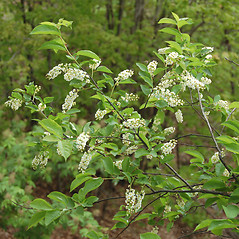| Common Name(s) | Black Cherry | ||||
| Scientific Name | Prunus serotina | ||||
| Family | Rosaceae | ||||
| Location/Vegetative Zone | Thickets | ||||
| Flowering Period | Spring, March-June | ||||
| Identifying Characteristics | Tree about 49–98 ft tall, white flowers and green to red to black round fruits | ||||
Description
- Deciduous tree
- 49-98 ft tall, trunk up to 28–47 in around
- Leaves are:
- Oval, serrated at the edge
- 2.4–5.5 in
- Light to medium green
- Smooth, glossy and waxy
- Flowers:
- 5 white petals
- Small flowers, 0.39–0.59 in
- Blooms March-June
- Fertilizes late summer to fall; fruit is a drupe, ½in in diameter
- Fruit is green to red at first, then ripening to black
- Fruit is astringent and bitter when eaten fresh, but also somewhat sweet
Medicinal/Edible Uses
- Cherries eaten raw (must be pitted) and used in jellies, jams, pies, and as a flavoring extract in drinks and syrups
- Inner bark used in cough syrups, sedatives, and tonics
Cultural Uses
- Wood used for lumber, paneling, and furniture
- Fruit used in pies, jellies, and jams
Misc
- Habitat
- Thickets, woodlands, canyons, floodplains, and lower riparian slopes
- Likes moist or dry, open woods
- Likes moderate amounts of water and sun, part shade, or shade
- Native to eastern North America: from eastern Canada through southern Quebec and Ontario; south through the eastern United States to Texas and central Florida
- Moderately long-lived tree, aging up to 258 years old
- Fruit is readily eaten by birds
- The bark, leaves, and seeds of this species are highly toxic to humans and herbivorous mammals, and may be fatal if ingested
Sources
Nesom, Guy. “BLACK CHERRY”. United States Department of Agriculture. USDA NRCS. Web.
2,062 total views, 1 views today

